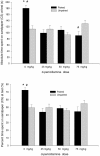An acetaldehyde-sequestering agent inhibits appetitive reinforcement and behavioral stimulation induced by ethanol in preweanling rats
- PMID: 20951160
- PMCID: PMC3214973
- DOI: 10.1016/j.pbb.2010.10.005
An acetaldehyde-sequestering agent inhibits appetitive reinforcement and behavioral stimulation induced by ethanol in preweanling rats
Abstract
Ethanol's motivational consequences have been related to the actions of acetaldehyde, a metabolic product of ethanol oxidation. The present study assessed the role of acetaldehyde in the motivational effects of ethanol on preweanling rats. In Experiment 1 pups (postnatal days 13-14, PD 13-14) were given systemic administration of D-penicillamine (DP, a drug that sequesters acetaldehyde: 0, 25, 50 or 75 mg/kg) before pairings of 1.0 g/kg ethanol and a rough surface (sandpaper, conditioned stimulus, CS). At test, pups given sandpaper-ethanol pairings exhibited greater preference for the CS than unpaired controls, but this preference was not expressed by pups given DP. Pre-training administration of 25 or 50 mg/kg DP completely blocked the expression of ethanol-mediated appetitive conditioning. D-penicillamine did not alter blood ethanol levels. Subsequent experiments revealed that ethanol-induced activation was blocked by central (intra-cisterna magna injections, volume: 1 μl, dose: 0 or 75 μg) but not systemic treatment with DP (0, 25, 50 or 75 mg/kg; ip). These results indicate that: (a) preweanling rats are sensitive to the reinforcing effect of ethanol, and (b) that this effect is associated with the motor activating effect of the drug. These effects seem to be mediated by the first metabolite of ethanol, acetaldehyde.
Copyright © 2010 Elsevier Inc. All rights reserved.
Figures



Similar articles
-
Infantile sensitivity to ethanol's motivational effects: Ethanol reinforcement during the third postnatal week.Alcohol Clin Exp Res. 2006 Sep;30(9):1506-19. doi: 10.1111/j.1530-0277.2006.00182.x. Alcohol Clin Exp Res. 2006. PMID: 16930213
-
Ethanol-induced conditioned place preference, but not aversion, is blocked by treatment with D -penicillamine, an inactivation agent for acetaldehyde.Psychopharmacology (Berl). 2006 Jan;184(1):56-64. doi: 10.1007/s00213-005-0224-z. Epub 2005 Dec 13. Psychopharmacology (Berl). 2006. PMID: 16344987
-
The role of acetaldehyde in ethanol reinforcement assessed by Pavlovian conditioning in newborn rats.Psychopharmacology (Berl). 2013 Apr;226(3):491-9. doi: 10.1007/s00213-012-2920-9. Epub 2012 Dec 1. Psychopharmacology (Berl). 2013. PMID: 23196716
-
The role of acetaldehyde in the neurobehavioral effects of ethanol: a comprehensive review of animal studies.Prog Neurobiol. 2005 Mar;75(4):247-74. doi: 10.1016/j.pneurobio.2005.03.003. Epub 2005 Apr 26. Prog Neurobiol. 2005. PMID: 15882776 Review.
-
Assessing appetitive, aversive, and negative ethanol-mediated reinforcement through an immature rat model.Neurosci Biobehav Rev. 2009 Jun;33(6):953-74. doi: 10.1016/j.neubiorev.2009.03.008. Epub 2009 Mar 24. Neurosci Biobehav Rev. 2009. PMID: 19428502 Free PMC article. Review.
Cited by
-
Salsolinol stimulates dopamine neurons in slices of posterior ventral tegmental area indirectly by activating μ-opioid receptors.J Pharmacol Exp Ther. 2012 Apr;341(1):43-50. doi: 10.1124/jpet.111.186833. Epub 2011 Dec 30. J Pharmacol Exp Ther. 2012. PMID: 22209890 Free PMC article.
-
Acetaldehyde reinforcement and motor reactivity in newborns with or without a prenatal history of alcohol exposure.Front Behav Neurosci. 2013 Jun 17;7:69. doi: 10.3389/fnbeh.2013.00069. eCollection 2013. Front Behav Neurosci. 2013. PMID: 23785319 Free PMC article.
-
Acetaldehyde involvement in ethanol's postabsortive effects during early ontogeny.Front Behav Neurosci. 2013 Jun 19;7:70. doi: 10.3389/fnbeh.2013.00070. eCollection 2013. Front Behav Neurosci. 2013. PMID: 23801947 Free PMC article.
-
The Role of Acetaldehyde in the Increased Acceptance of Ethanol after Prenatal Ethanol Exposure.Front Behav Neurosci. 2017 Jan 31;11:14. doi: 10.3389/fnbeh.2017.00014. eCollection 2017. Front Behav Neurosci. 2017. PMID: 28197082 Free PMC article.
-
α-Lipoic acid, a scavenging agent for H₂O₂, reduces ethanol-stimulated locomotion in mice.Psychopharmacology (Berl). 2012 Jan;219(1):171-80. doi: 10.1007/s00213-011-2407-0. Epub 2011 Jul 19. Psychopharmacology (Berl). 2012. PMID: 21769567
References
-
- Appel SB, Liu Z, McElvain MA, Brodie MS. Ethanol excitation of dopaminergic ventral tegmental area neurons is blocked by quinidine. Journal of Pharmacology and Experimental Therapeutics. 1986;306:437–46. - PubMed
-
- Aragon CM, Abitbol M, Amit Z. Acetaldehyde may mediate reinforcement and aversion produced by ethanol. An examination using a conditioned taste-aversion paradigm. Neuropharmacology. 2003;25:79–83. - PubMed
-
- Aragon CM, Rogan F, Amit Z. Ethanol metabolism in rat brain homogenates by a catalase-H2O2 system. Biochem Pharmacol. 1992;44:93–98. - PubMed
-
- Aragon CM, Spivak K, Amit Z. Blockade of ethanol induced conditioned taste aversion by 3-amino-1,2,4-triazole: evidence for catalase mediated synthesis of acetaldehyde in rat brain. Life Sci. 1985;37:2077–84. - PubMed
Publication types
MeSH terms
Substances
Grants and funding
LinkOut - more resources
Full Text Sources

